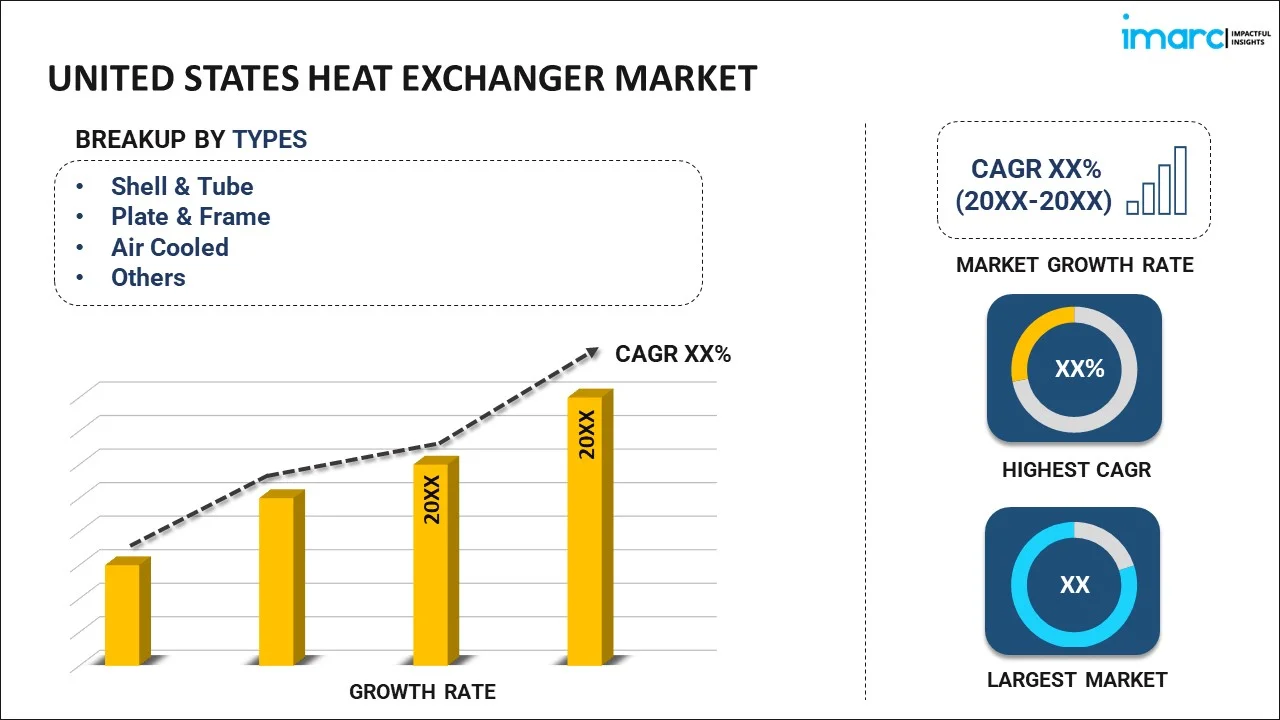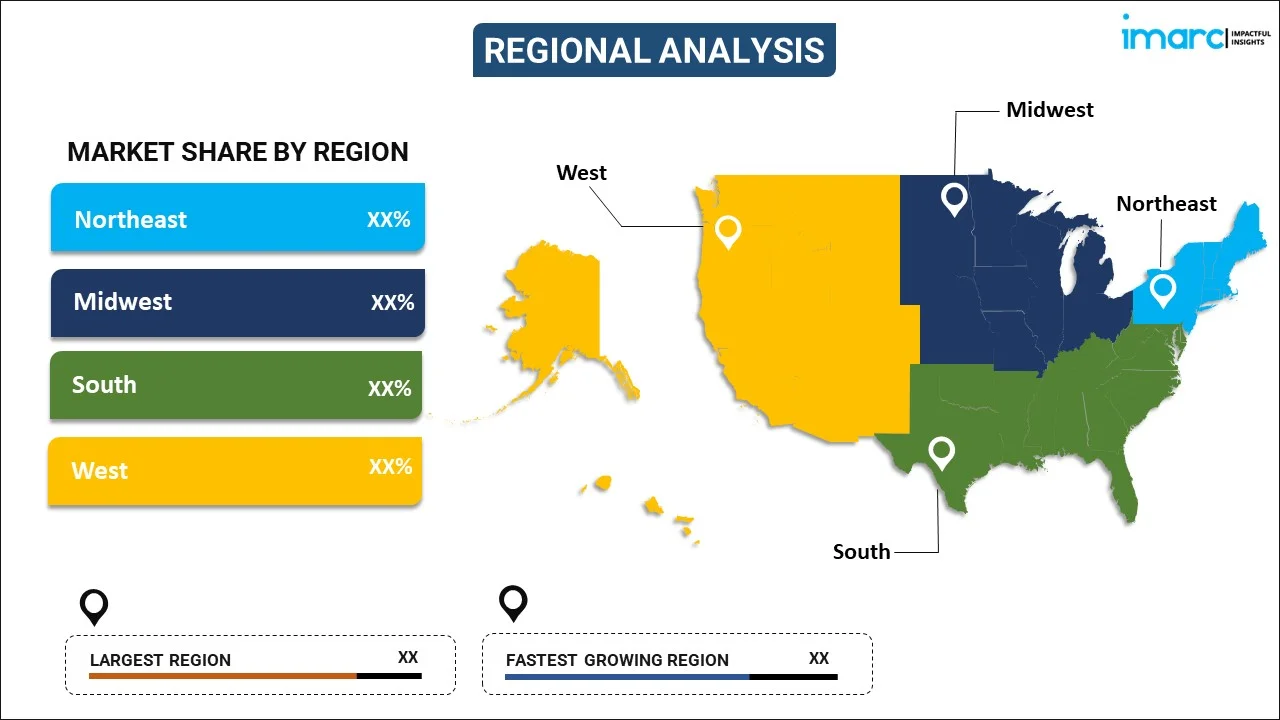
United States Heat Exchanger Market Report by Type (Shell & Tube, Plate & Frame, Air Cooled, and Others), Material (Carbon Steel, Stainless Steel, Nickel, and Others), End Use Industry (Chemical, Petrochemical and Oil & Gas, HVAC and Refrigeration, Food & Beverage, Power Generation, Paper & Pulp, and Others), and Region 2025-2033
Market Overview:
The United States heat exchanger market size reached USD 3.8 Billion in 2024. Looking forward, IMARC Group expects the market to reach USD 5.7 Billion by 2033, exhibiting a growth rate (CAGR) of 4.27% during 2025-2033.
|
Report Attribute
|
Key Statistics
|
|---|---|
|
Base Year
|
2024
|
|
Forecast Years
|
2025-2033
|
|
Historical Years
|
2019-2024
|
|
Market Size in 2024
|
USD 3.8 Billion |
|
Market Forecast in 2033
|
USD 5.7 Billion |
| Market Growth Rate (2025-2033) | 4.27% |
Heat exchangers are devices utilized for transferring heat from one fluid to another and controlling the temperature of a substance or a system. These devices comprise streams of hot and cold liquids that are used to transfer thermal energy. As they enable the efficient functioning of machines and engines, they find extensive application in refrigerators, furnaces, sewage treatments, air conditioning systems, boilers and automotive radiators across the United States.
The United States represents one of the largest markets for heat exchangers. This can be accredited to the burgeoning oil and gas industry, along with the growing number of exploration and production (E&P) activities being undertaken in the country. Furthermore, the escalating demand for heat exchangers in industrial and commercial sectors is strengthening the growth of the market. Apart from this, heat exchangers also find application in chemical plants, which can be attributed to the varying temperature requirements of streams in different processes. Other factors fueling the market growth include the installation of superficial heat exchangers to upgrade the existing power units and minimize carbon emissions. However, the coronavirus disease (COVID-19) outbreak has disrupted manufacturing operations and impacted the supply chain across the country. This has negatively affected market growth, but once the vaccination is introduced and COVID-19 cases subside, the demand for heat exchangers will witness growth.
Key Market Segmentation:
IMARC Group provides an analysis of the key trends in each sub-segment of the United States heat exchanger market report, along with forecasts at the country level from 2025-2033. Our report has categorized the market based on type, material, and end use industry.
Breakup by Type:

- Shell & Tube
- Plate & Frame
- Air Cooled
- Others
Breakup by Material:
- Carbon Steel
- Stainless Steel
- Nickel
- Others
Breakup by End Use Industry:
- Chemical
- Petrochemical and Oil & Gas
- HVAC and Refrigeration
- Food & Beverage
- Power Generation
- Paper & Pulp
- Others
Breakup by Region:

- Northeast
- Midwest
- South
- West
Competitive Landscape:
The competitive landscape of the industry has also been examined along with the profiles of the key players.
Report Coverage:
| Report Features | Details |
|---|---|
| Base Year of the Analysis | 2024 |
| Historical Period | 2019-2024 |
| Forecast Period | 2025-2033 |
| Units | Billion USD |
| Segment Coverage | Type, Material, End Use Industry, Region |
| Region Covered | Northeast, Midwest, South, West |
| Customization Scope | 10% Free Customization |
| Post-Sale Analyst Support | 10-12 Weeks |
| Delivery Format | PDF and Excel through Email (We can also provide the editable version of the report in PPT/Word format on special request) |
Key Questions Answered in This Report
The United States heat exchanger market was valued at USD 3.8 Billion in 2024.
We expect the United States heat exchanger market to exhibit a CAGR of 4.27% during 2025-2033.
The extensive utilization of heat exchangers in boilers, furnaces, refrigerators, automotive radiators, sewage treatment, and air conditioning systems, is currently driving the United States heat exchanger market.
The sudden outbreak of the COVID-19 pandemic had led to the implementation of stringent lockdown regulations across the United States resulting in temporary closure of numerous manufacturing units of heat exchangers.
Based on the type, the United States heat exchanger market can be divided into shell & tube, plate & frame, air cooled, and others. Currently, shell & tube exhibits a clear dominance in the market.
Based on the material, the United States heat exchanger market has been bifurcated into carbon steel, stainless steel, nickel, and others. Among these, stainless steel holds the majority of the total market share.
Based on the end use industry, the United States heat exchanger market can be segmented into chemical, petrochemical and oil & gas, HVAC and refrigeration, food & beverage, power generation, paper & pulp, and others. Currently, the chemical industry represents the largest market share.
On a regional level, the market has been classified into Northeast, Midwest, South, and West, where South currently dominates the market.
Need more help?
- Speak to our experienced analysts for insights on the current market scenarios.
- Include additional segments and countries to customize the report as per your requirement.
- Gain an unparalleled competitive advantage in your domain by understanding how to utilize the report and positively impacting your operations and revenue.
- For further assistance, please connect with our analysts.
 Inquire Before Buying
Inquire Before Buying
 Speak to an Analyst
Speak to an Analyst
 Request Brochure
Request Brochure
 Request Customization
Request Customization




.webp)




.webp)












